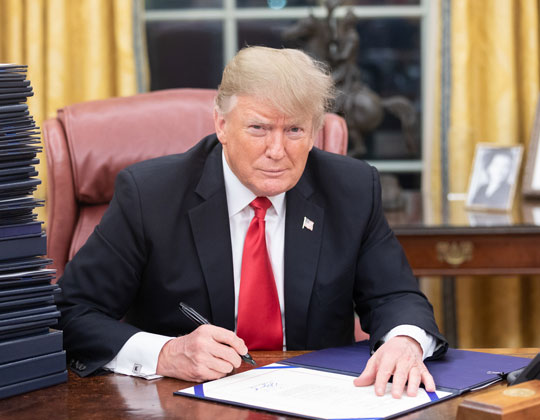Donald John Trump served as the 45th president of the United States for a complete term spanning four years. His presidency began on January 20, 2017, and ended on January 20, 2021. In this article, we’ll examine the length and key moments of Trump’s time in office, touching on notable aspects of his presidency and its lasting impact on American politics and society.
1. Duration of Trump’s Presidency
Donald Trump served exactly one term—four years—as president, from January 20, 2017, to January 20, 2021. As outlined by the U.S. Constitution, a presidential term is four years, with a limit of two terms (eight years) for any individual. Trump ran for re-election in 2020 but lost to the Democratic candidate Joe Biden, marking the end of his presidency on Inauguration Day 2021.
2. Key Moments During Trump’s Presidency
Trump’s time in office was marked by a series of significant events, policy decisions, and controversies. Here’s a look at some of the most notable moments:
- Immigration Policy Changes: Trump focused on tightening immigration, including policies like the travel ban targeting predominantly Muslim-majority countries and heightened enforcement against undocumented immigrants. The construction of a wall along the U.S.-Mexico border was a prominent goal, though it remained unfinished at the end of his term.
- Tax Cuts and Jobs Act: One of Trump’s significant legislative achievements was the Tax Cuts and Jobs Act of 2017. This tax reform lowered the corporate tax rate and offered temporary tax relief for individuals, which supporters argued would stimulate economic growth.
- Trade Policies and Tariffs: Trump implemented an “America First” trade policy, including tariffs on imported steel, aluminum, and Chinese goods. His administration aimed to reduce the trade deficit and bring manufacturing jobs back to the U.S. These moves led to trade tensions, particularly with China.
- COVID-19 Pandemic: Perhaps the most defining moment of Trump’s presidency came in 2020 with the outbreak of COVID-19. Trump’s response to the pandemic faced widespread criticism and sparked debate about public health and the economy. The federal government’s handling of testing, mask-wearing, and vaccine development became focal points of both praise and criticism.
- Judicial Appointments: During his term, Trump appointed three Supreme Court Justices: Neil Gorsuch, Brett Kavanaugh, and Amy Coney Barrett. These appointments significantly shifted the court’s ideological balance toward conservatism, impacting future rulings on abortion, healthcare, and other critical issues.
- Relations with North Korea and International Diplomacy: Trump’s approach to foreign relations was unconventional. He met North Korean leader Kim Jong-un in an attempt to address nuclear disarmament, becoming the first sitting U.S. president to meet with a North Korean leader. However, these efforts did not lead to significant policy changes.
3. Trump’s Re-Election Campaign and the 2020 Election
Trump’s term ended after he lost the 2020 presidential election to Joe Biden, but the election aftermath drew unprecedented controversy. Trump and his supporters alleged widespread voter fraud, though these claims were repeatedly rejected in court. On January 6, 2021, shortly before Trump’s term ended, the U.S. Capitol was stormed by a mob following a rally in which Trump urged his supporters to “fight like hell” to contest the election results.
The events of January 6th led to Trump’s second impeachment by the House of Representatives on charges of incitement to insurrection. Though he was acquitted by the Senate, the attack on the Capitol marked a contentious close to Trump’s presidency.
4. Legacy and Impact of Trump’s Presidency
Donald Trump’s presidency left a lasting mark on U.S. politics. Here are a few key elements of his legacy:
- Polarization: Trump’s rhetoric and policies often deepened political and social divides, sparking fierce loyalty among his base and strong opposition from critics. His use of social media to communicate directly with the public bypassed traditional news channels but also led to accusations of spreading misinformation.
- Economic Shifts: Trump’s economic policies, including tax cuts and deregulation, had a significant impact on the economy. Unemployment dropped to historic lows before the pandemic, but the economic fallout from COVID-19 overshadowed earlier gains.
- Influence on the Republican Party: Trump’s influence on the Republican Party has been profound. His populist approach reshaped party priorities, and even after leaving office, he maintained a significant following and influence over the party’s direction.
- Judicial Impact: With three Supreme Court justices appointed, Trump’s legacy includes a shift in the judicial branch that will likely influence American legal precedents for decades.
5. Conclusion
Donald Trump served as president of the United States for exactly four years, leaving office on January 20, 2021. His presidency was marked by a blend of economic policy changes, judicial appointments, foreign policy initiatives, and significant controversy. The long-term effects of his administration continue to shape American politics and society, demonstrating that the legacy of a president can endure far beyond their time in office.



